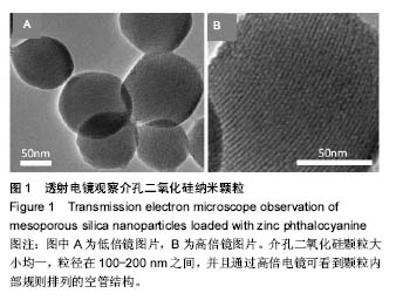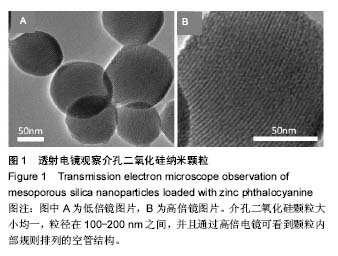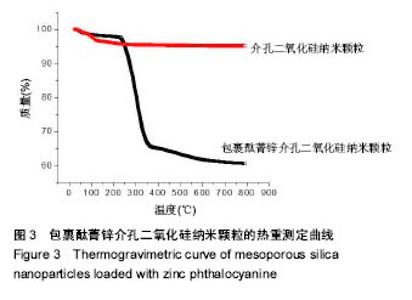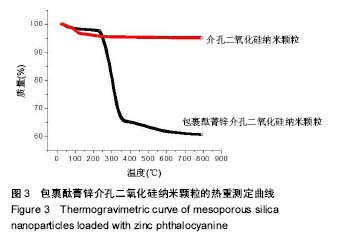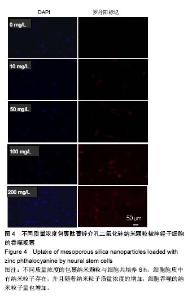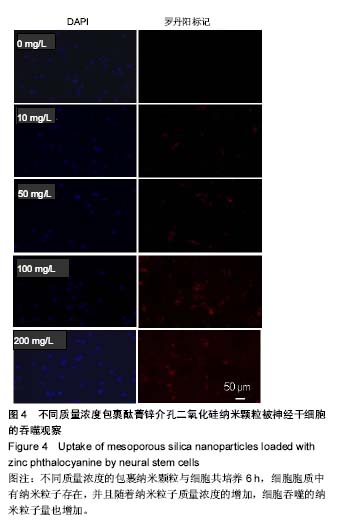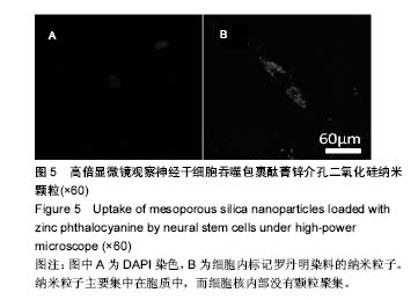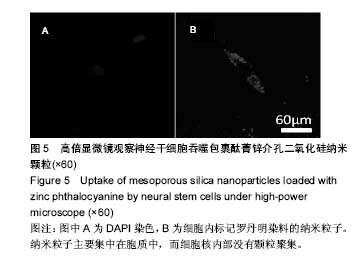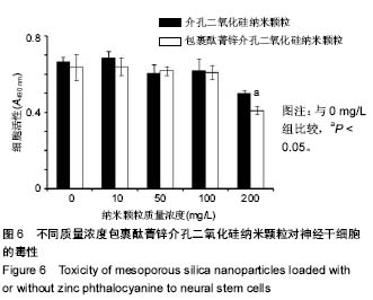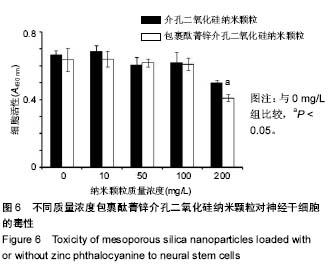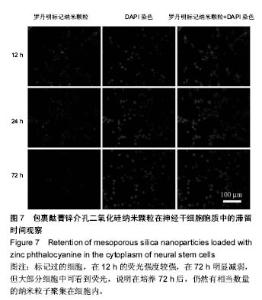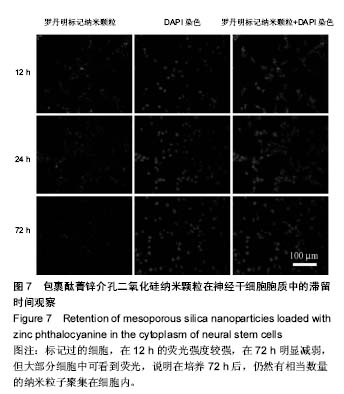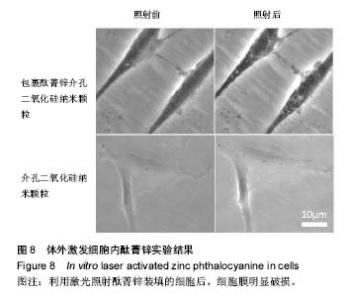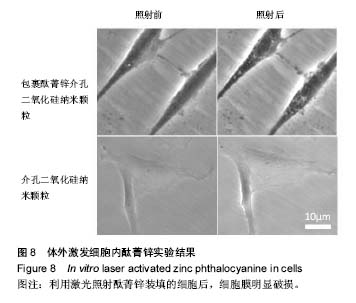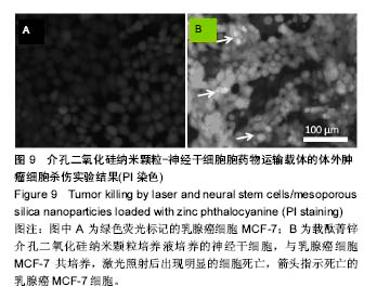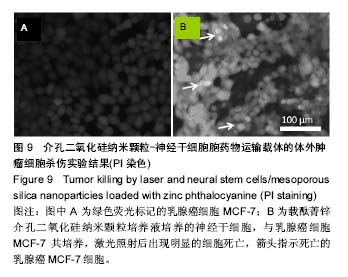Chinese Journal of Tissue Engineering Research ›› 2018, Vol. 22 ›› Issue (6): 883-888.doi: 10.3969/j.issn.2095-4344.0063
Previous Articles Next Articles
A targeting photodynamic drug vehicle composed of neural stem cells and mesoporous silica nanoparticles for tumor therapy
- 1Xinhua College of Sun Yat-sen University, Guangzhou 523145, Guangdong Province, China; 2Pharmacy School of Sun Yat-sen University, Guangzhou 510006, Guangdong Province, China
-
Received:2017-09-08Online:2018-02-28Published:2018-02-28 -
Contact:Chen Jia-shu, Professor, Pharmacy School of Sun Yat-sen University, Guangzhou 510006, Guangdong Province, China -
About author:Zhang Wei-jia, Lecturer, Xinhua College of Sun Yat-sen University, Guangzhou 523145, Guangdong Province, China
CLC Number:
Cite this article
Zhang Wei-jia, Chen Jia-shu. A targeting photodynamic drug vehicle composed of neural stem cells and mesoporous silica nanoparticles for tumor therapy[J]. Chinese Journal of Tissue Engineering Research, 2018, 22(6): 883-888.
share this article
Add to citation manager EndNote|Reference Manager|ProCite|BibTeX|RefWorks
| [1]Sirotkina MA,Matveev LA,Shirmanova MV,et al.Photodynamic therapy monitoring with optical coherence angiography.Sci Rep.2017;7:41506. [2]Ma?dziarz A,Osuch B,Kowalska M,et al.Photodynamic Therapy in the Treatment of Vulvar Lichen Sclerosus.Photodiagnosis Photodyn Ther. 2017.pii: S1572-1000(17)30230-2. [3]Pérez-Laguna V,Pérez-Artiaga L,Lampaya-Pérez V,et al.Comparative effect of photodynamic therapy on separated or mixed cultures of Streptococcus mutans and Streptococcus sanguinis.Photodiagnosis Photodyn Ther.2017. pii: S1572-1000(17)30234-X. doi: 10.1016/j.pdpdt.2017.05.017. [Epub ahead of print][4]Li X,Gao M,Xin K,et al.Singlet oxygen-responsive micelles for enhanced photodynamic therapy.J Control Release.2017;260:12-21. [5]Gu B,Wu W,Xu G,et al.Precise Two-Photon Photodynamic Therapy using an Efficient Photosensitizer with Aggregation-Induced Emission Characteristics.Adv Mater. 2017. doi: 10.1002/adma.201701076. [Epub ahead of print][6]Jang Y,Kim S, Lee S,et al.Graphene Oxide Wrapped SiO2 /TiO2 Hollow Nanoparticles Loaded with Photosensitizer for Photothermal and Photodynamic Combination Therapy.Chemistry. 2017;23(15):3719-3727.[7]Abbaraju PL,Yang Y,Yu M,et al.Core-Shell-structured Dendritic Mesoporous Silica Nanoparticles for Combined Photodynamic Therapy and Antibody Delivery.Chem Asian J. 2017. doi: 10.1002/asia.201700392. [Epub ahead of print][8]Lin L,Xiong L,Wen Y,et al.Active Targeting of Nano-Photosensitizer Delivery Systems for Photodynamic Therapy of Cancer Stem Cells.J Biomed Nanotechnol.2015;11(4):531-554.[9]Usacheva M,Swaminathan SK,Kirtane AR,et al.Enhanced photodynamic therapy and effective elimination of cancer stem cells using surfactant-polymer nanoparticles.Mol Pharm.2014;11(9):3186-3195. [10]Yu CH,Yu CC.Photodynamic therapy with 5-aminolevulinic acid (ALA) impairs tumor initiating and chemo-resistance property in head and neck cancer-derived cancer stem cells.PLoS One. 2014;9(1):e87129. [11]Matamoros-Angles A,Gayosso LM,Richaud-Patin Y,et al.iPS Cell Cultures from a Gerstmann-Sträussler-Scheinker Patient with the Y218N PRNP Mutation Recapitulate tau Pathology.Mol Neurobiol.2017.doi: 10.1007/s12035-017-0506-6. [Epub ahead of print][12]Csobonyeiova M,Polak S,Zamborsky R,et al.iPS cell technologies and their prospect for bone regeneration and disease modeling: A mini review. J Adv Res.2017;8(4):321-327. [13]Wrighton KH.Stem cells: The different flavours of iPS cells.Nat Rev Genet. 2017;18(7):394. [14]Hung CW,Liou YJ,Lu SW,et al.Stem cell-based neuroprotective and neurorestorative strategies.Int J Mol Sci.2010;11(5):2039-2055. [15]Natesan S,Krishnaswami V,Ponnusamy C,et al.Hypocrellin B and nano silver loaded polymeric nanoparticles: Enhanced generation of singlet oxygen for improved photodynamic therapy.Mater Sci Eng C Mater Biol Appl.2017;77:935-946.[16]Pramual S,Lirdprapamongkol K,Svasti J,et al.Polymer-lipid-PEG hybrid nanoparticles as photosensitizer carrier for photodynamic therapy.J Photochem Photobiol B.2017;173:12-22.[17]Mistry A,Pereira R,Kini V,et al.Effect of Combined Therapy Using Diode Laser and Photodynamic Therapy on Levels of IL-17 in Gingival Crevicular Fluid in Patients With Chronic Periodontitis.J Lasers Med Sci.2016;7(4):250-255. [18]Gracia-Cazaña T,González S,Juarranz A,et al.Methyl aminolevulinate photodynamic therapy combined with curettage debulking for pigmented basal cell carcinoma.Photodermatol Photoimmunol Photomed. 2017.doi:10.1111/phpp.12313.[Epub ahead of print][19]Gao C, Lin Z,Wu Z,et al.Stem-Cell-Membrane Camouflaging on Near-Infrared Photoactivated Upconversion Nanoarchitectures for in Vivo Remote-Controlled Photodynamic Therapy.ACS Appl Mater Interfaces.2016;8(50):34252-34260.[20]Cho SJ,Kim SY,Park SJ,et al. Photodynamic Approach for Teratoma-Free Pluripotent Stem Cell Therapy Using CDy1 and Visible Light.ACS Cent Sci.2016;2(9):604-607.[21]Shrestha TB,Seo GM,Basel MT,et al.Stem cell-based photodynamic therapy.Photochem Photobiol Sci. 2012;11(7):1251-1258. [22]Choi HW,Kim JS,Choi S,et al.Neural stem cells differentiated from iPS cells spontaneously regain pluripotency.Stem Cells.2014;32(10): 2596-2604. [23]Sun J,Mandai M,Kamao H,et al.Protective Effects of Human iPS-Derived Retinal Pigmented Epithelial Cells in Comparison with Human Mesenchymal Stromal Cells and Human Neural Stem Cells on the Degenerating Retina in rd1 mice.Stem Cells.2015;33(5): 1543-1553. [24]Elvira G,Moreno B,Valle ID,et al.Targeting neural stem cells with titanium dioxide nanoparticles coupled to specific monoclonal antibodies.J Biomater Appl.2012;26(8):1069-1089. [25]Liu F,Mahmood M,Xu Y,et al.Effects of silver nanoparticles on human and rat embryonic neural stem cells.Front Neurosci.2015;9:115.[26]Lui CN,Tsui YP,Ho AS,et al.Neural stem cells harvested from live brains by antibody-conjugated magnetic nanoparticles.Angew Chem Int Ed Engl.2013;52(47):12298-12302.[27]Ruiz-Cabello J,Walczak P,Kedziorek DA,et al.In vivo "hot spot" MR imaging of neural stem cells using fluorinated nanoparticles.Magn Reson Med.2008;60(6):1506-1511.[28]Delcroix GJ,Jacquart M,Lemaire L,et al.Mesenchymal and neural stem cells labeled with HEDP-coated SPIO nanoparticles: in vitro characterization and migration potential in rat brain.Brain Res.2009; 1255:18-31.[29]Kim J,Yang K,Lee JS,et al.Enhanced Self-Renewal and Accelerated Differentiation of Human Fetal Neural Stem Cells Using Graphene Oxide Nanoparticles.Macromol Biosci. 2017.doi: 10.1002/mabi.201600540. [Epub ahead of print].[30]Zou F,Zhou W,Guan W,et al.Screening of Photosensitizers by Chemiluminescence Monitoring of Formation Dynamics of Singlet Oxygen during Photodynamic Therapy.Anal Chem. 2016;88(19): 9707-9713. |
| [1] | Zhang Tongtong, Wang Zhonghua, Wen Jie, Song Yuxin, Liu Lin. Application of three-dimensional printing model in surgical resection and reconstruction of cervical tumor [J]. Chinese Journal of Tissue Engineering Research, 2021, 25(9): 1335-1339. |
| [2] | Guan Qian, Luan Zuo, Ye Dou, Yang Yinxiang, Wang Zhaoyan, Wang Qian, Yao Ruiqin. Morphological changes in human oligodendrocyte progenitor cells during passage [J]. Chinese Journal of Tissue Engineering Research, 2021, 25(7): 1045-1049. |
| [3] | Zeng Yanhua, Hao Yanlei. In vitro culture and purification of Schwann cells: a systematic review [J]. Chinese Journal of Tissue Engineering Research, 2021, 25(7): 1135-1141. |
| [4] | Xu Dongzi, Zhang Ting, Ouyang Zhaolian. The global competitive situation of cardiac tissue engineering based on patent analysis [J]. Chinese Journal of Tissue Engineering Research, 2021, 25(5): 807-812. |
| [5] | Wu Zijian, Hu Zhaoduan, Xie Youqiong, Wang Feng, Li Jia, Li Bocun, Cai Guowei, Peng Rui. Three-dimensional printing technology and bone tissue engineering research: literature metrology and visual analysis of research hotspots [J]. Chinese Journal of Tissue Engineering Research, 2021, 25(4): 564-569. |
| [6] | Chang Wenliao, Zhao Jie, Sun Xiaoliang, Wang Kun, Wu Guofeng, Zhou Jian, Li Shuxiang, Sun Han. Material selection, theoretical design and biomimetic function of artificial periosteum [J]. Chinese Journal of Tissue Engineering Research, 2021, 25(4): 600-606. |
| [7] | Liu Fei, Cui Yutao, Liu He. Advantages and problems of local antibiotic delivery system in the treatment of osteomyelitis [J]. Chinese Journal of Tissue Engineering Research, 2021, 25(4): 614-620. |
| [8] | Li Xiaozhuang, Duan Hao, Wang Weizhou, Tang Zhihong, Wang Yanghao, He Fei. Application of bone tissue engineering materials in the treatment of bone defect diseases in vivo [J]. Chinese Journal of Tissue Engineering Research, 2021, 25(4): 626-631. |
| [9] | Zhang Zhenkun, Li Zhe, Li Ya, Wang Yingying, Wang Yaping, Zhou Xinkui, Ma Shanshan, Guan Fangxia. Application of alginate based hydrogels/dressings in wound healing: sustained, dynamic and sequential release [J]. Chinese Journal of Tissue Engineering Research, 2021, 25(4): 638-643. |
| [10] | Chen Jiana, Qiu Yanling, Nie Minhai, Liu Xuqian. Tissue engineering scaffolds in repairing oral and maxillofacial soft tissue defects [J]. Chinese Journal of Tissue Engineering Research, 2021, 25(4): 644-650. |
| [11] | Xing Hao, Zhang Yonghong, Wang Dong. Advantages and disadvantages of repairing large-segment bone defect [J]. Chinese Journal of Tissue Engineering Research, 2021, 25(3): 426-430. |
| [12] | Chen Siqi, Xian Debin, Xu Rongsheng, Qin Zhongjie, Zhang Lei, Xia Delin. Effects of bone marrow mesenchymal stem cells and human umbilical vein endothelial cells combined with hydroxyapatite-tricalcium phosphate scaffolds on early angiogenesis in skull defect repair in rats [J]. Chinese Journal of Tissue Engineering Research, 2021, 25(22): 3458-3465. |
| [13] | Wang Hao, Chen Mingxue, Li Junkang, Luo Xujiang, Peng Liqing, Li Huo, Huang Bo, Tian Guangzhao, Liu Shuyun, Sui Xiang, Huang Jingxiang, Guo Quanyi, Lu Xiaobo. Decellularized porcine skin matrix for tissue-engineered meniscus scaffold [J]. Chinese Journal of Tissue Engineering Research, 2021, 25(22): 3473-3478. |
| [14] | Mo Jianling, He Shaoru, Feng Bowen, Jian Minqiao, Zhang Xiaohui, Liu Caisheng, Liang Yijing, Liu Yumei, Chen Liang, Zhou Haiyu, Liu Yanhui. Forming prevascularized cell sheets and the expression of angiogenesis-related factors [J]. Chinese Journal of Tissue Engineering Research, 2021, 25(22): 3479-3486. |
| [15] | Liu Chang, Li Datong, Liu Yuan, Kong Lingbo, Guo Rui, Yang Lixue, Hao Dingjun, He Baorong. Poor efficacy after vertebral augmentation surgery of acute symptomatic thoracolumbar osteoporotic compression fracture: relationship with bone cement, bone mineral density, and adjacent fractures [J]. Chinese Journal of Tissue Engineering Research, 2021, 25(22): 3510-3516. |
| Viewed | ||||||
|
Full text |
|
|||||
|
Abstract |
|
|||||
